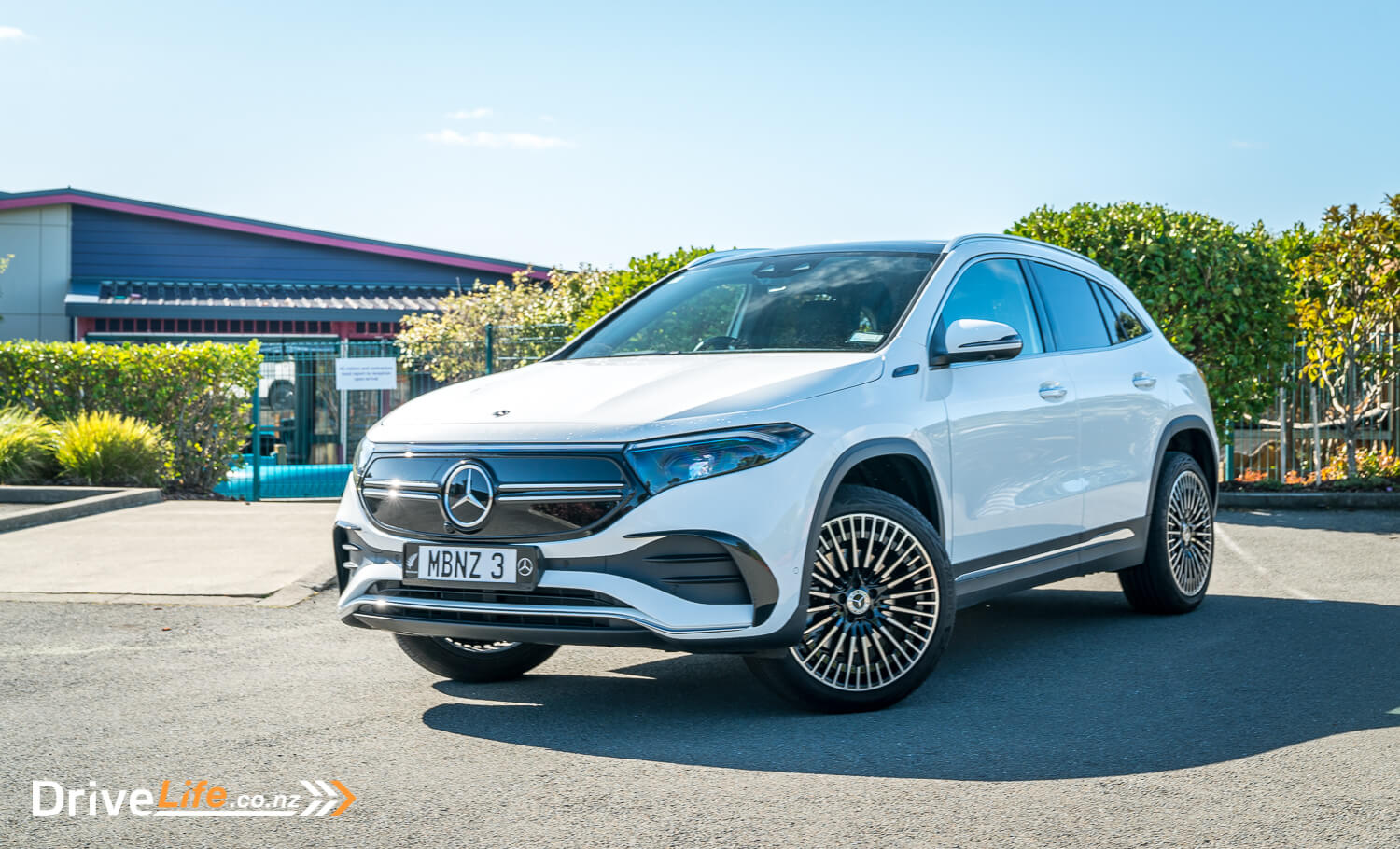This has been a model we’ve been waiting to review for a while now. A full battery-electric vehicle (BEV) from Mercedes-Benz for $85,500? This may still seem like a lot, but compare it to the humble (but very good) Hyundai Kona Elite EV at $85,990, and the Kia Niro EV Premium at $85,990 and you can see why the EQA is set to make waves.
But – can it? Has the EQA been cut down, built to a price to compete with the Japanese and Korean brands? The answer may well surprise you.
Mercedes-Benz New Zealand sent us an EQA 250 for an extended review, so we could all get behind the wheel as part of the New Zealand Car Of The Year voting process. This means that four of us will have our own points of view on this model.
Read on to find out what we all thought about this euro BEV, which has just been listed as being in the Top Ten of the New Zealand Car Of The Year award. That’s a high stake in the ground, and we hope the car lives up to it.
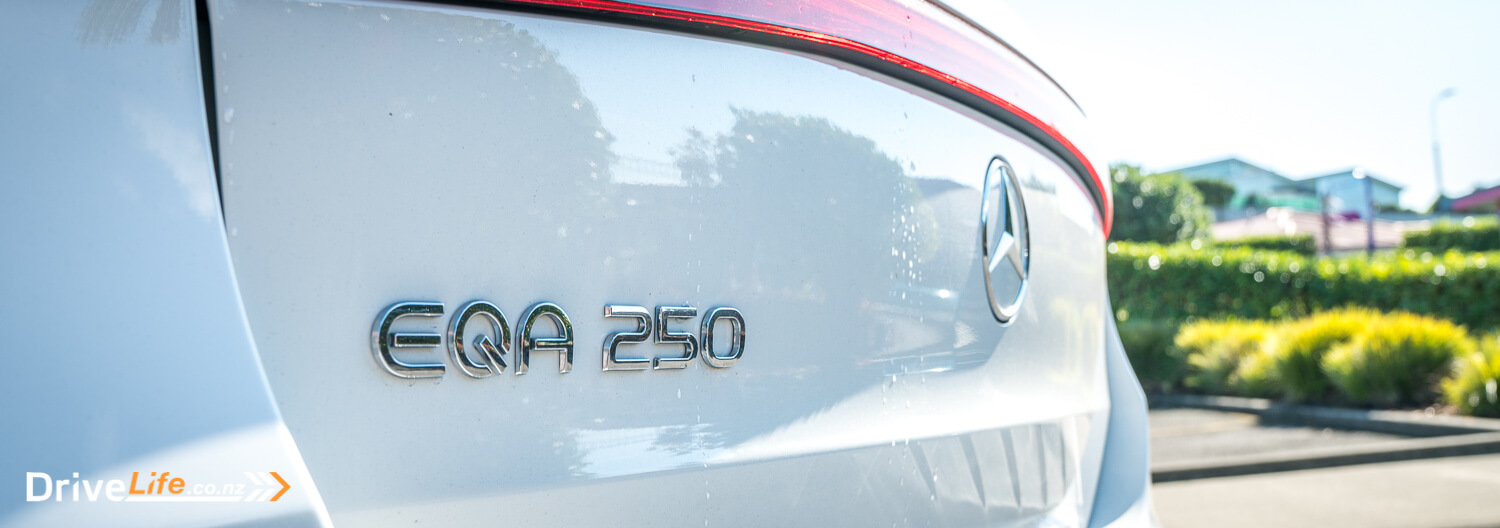
What We Like and Dislike About The 2021 Mercedes-Benz EQA 250
| What we like | What we don’t like |
| Handling Ride Quality of finish Value Equipment levels Range Steering wheel controls Wind, tyre, and road noise well subdued | Energy economy not great |
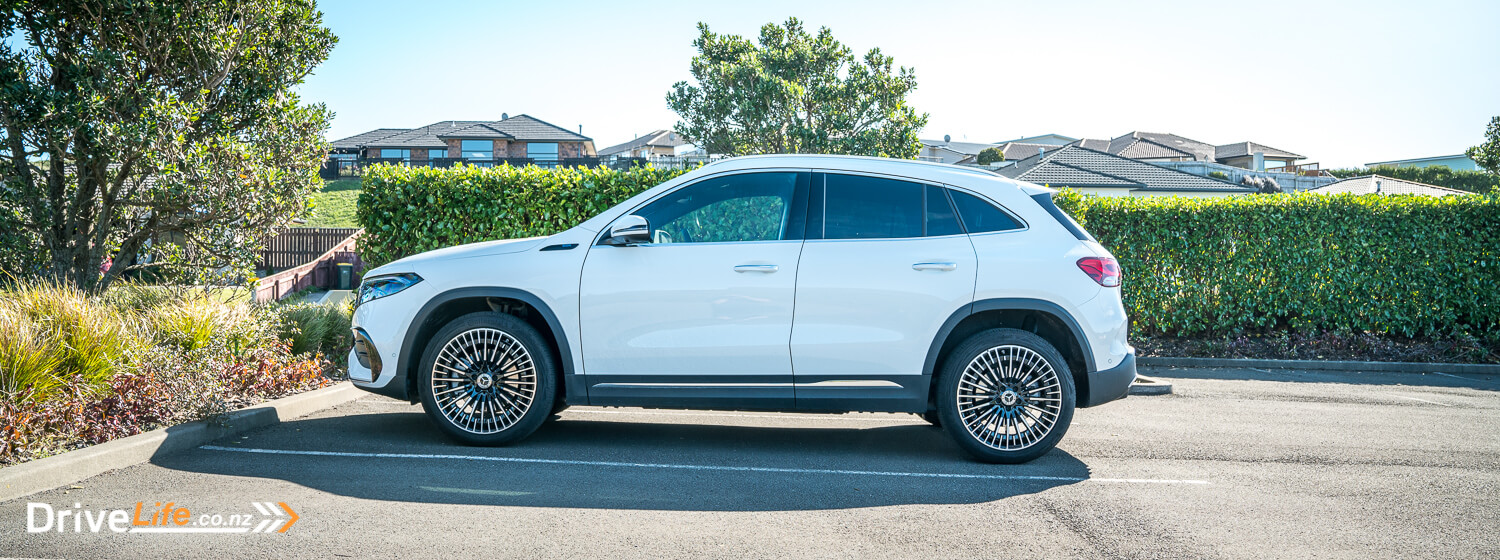
What’s In The Mercedes-BENZ EQA Range?
Well, choices are simple here. The model range consists of the EQA 250 – that’s it. While you can spec your EQA up in typical Mercedes-Benz fashion, currently there’s just one model in New Zealand. Mercedes-Benz New Zealand has confirmed that the all-wheel-drive EQA350 will be here in Q2 of 2022, with specs and pricing to come.
Battery capacity is generous at 66.5kWh. This may not mean anything to you, but it’s a little more than the Kona and Niro BEVs already mentioned (both 64kWh). More battery capacity equates to a higher range you can travel before having to recharge, and the WLTP rating for the EQA is up to 400Km. The car is front-wheel drive, with a single electric motor driving it.
While the price seems keen for this model, equipment levels are still relatively high.
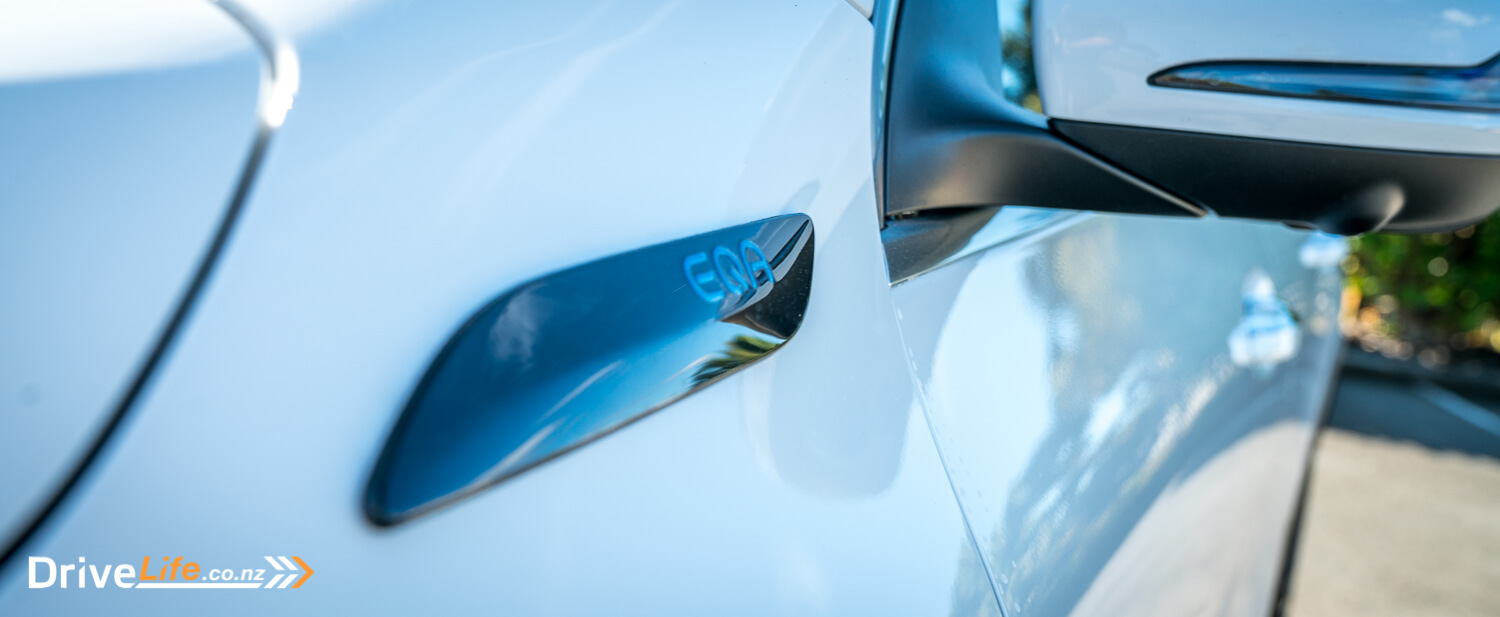
2021 Mercedes-Benz EQA 250 Standard Equipment Highlights
- 19″ AMG 5-twin-spoke light-alloy wheels, painted in high-gloss black with a high-sheen finish
- LED High-Performance headlamps with Adaptive Highbeam Assist and EQ specific blue elements
- Privacy glass from B pillar back
- Adaptive cruise control with Active Speed Limit Assist
- Route based adaptation
- Active Steering Assist
- Active Brake Assist
- Active Lane Keeping Assist
- Active Blind Spot Assist with Exit Warning Function
- Parking Package incl. Parking Assist PARKTRONIC and Reversing Camera
- KEYLESS-GO Comfort package incl. keyless entry and keyless start
- Electric Tailgate
- 9 airbags
- Traffic Sign Assist
- Adjustable suspension
- Tyre Pressure monitoring
- Two 10.25” displays
- Mercedes-Me Connect including Live Traffic, parked vehicle locator
- DAB radio
- Apple CarPlay and Android Auto
- Qi wireless phone charging
- Electric front seats with memory and electric lumbar adjust
- Heated front seats
- Dual-zone AC
- Ambient lighting (64 colours)
Options include climatised front seats, a wallbox charger for home, 5 interior colour/fabric options, 5 interior trim options, 3 wheel options, and 9 colour options:
- Polar White
- Night Black
- Denim Blue Metallic
- Rose Gold Metallic
- Digital White Metallic
- Iridium Silver Metallic
- Mountain Grey Metallic
- Cosmos Black Metallic
- Designo Mountain Grey MAGNO
Our Review Vehicle’s Optional Equipment
- AMG Line Sports Package $2,950
- Vision Package $2,900
- MBUX Innovation Package $2,500
- Black open-pore linden wood trim $300
Including the optional equipment, our review car’s retail price is $94,150 – up $8,650 from the base price of $85,500.
There is also a limited-time Edition 1 special package, priced at $7,300. This includes items such as:
- AMG-specific front apron with trim parts in chrome plus functional AIR CURTAINS
- AMG-specific black panel radiator grille in a twin-blade design and surround in high-gloss black
- AMG-specific rear apron in a diffuser look with trim part in high-gloss black lettering
- Black roof rails
- Exterior mirror housings in high-gloss black (in body colour when in conj. with paintwork in cosmos black)
- 20″ AMG multi-spoke light-alloy wheels, aerodynamically optimised, painted in matt copper with a high-sheen finish
- Electric Art Line with air vents in silver chrome and air guide ring in energy blue
- Upholstery in neva grey leather with CYBER CUT blue
- Door centre panels in neva grey leather with blue topstitching(
- Armrest in black ARTICO man-made leather with blue topstitching
- Spiral-look trim elements, backlit
- Air vents in silver chrome with outer ring in silver chrome and air guide ring in energy blue
- Sports multifunction steering wheel in nappa leather, with flat bottom and perforated grip
- AMG pedals in brushed stainless steel with rubber studs
- Door sill panels with illuminated “EQA” lettering in blue
- Edition 1 floor mats with blue “Edition 1” lettering and blue piping
- One vehicle key in black with ornamental surround in chrome and one vehicle key with ornamental surround in rose gold
For a full list of specs and options available for the 2021 Mercedes-Benz EQA 250, jump on over to the Mercedes-Benz New Zealand website.
How Does The 2021 Mercedes-Benz EQA 250 Compare To Its Competition?
We said the pricing was sharp, and we were right. This car is great value, although in all honesty, the Tesla Model3 looks like an absolute bargain.
Note that cars with a drive-away price of under $80,000 are eligible for the $8,625 Clean Car Programme rebate.
| Make/ Model | Battery Capacity kW/h | Power kW/Nm | 0-100km/h seconds | Range (WLTP) | Boot Space | Price |
| Hyundai Ioniq 5 Elite | 72.6 | 225/605 | 7.4 | 481 | 527 | $96,990 |
| Hyundai Kona EV Elite | 64 | 150/395 | 7.6 | 484 | 332 | $85,990 |
| Kia Niro EV Premium | 64 | 150/395 | 7.8 | 455 | 523 | $85,990 |
| Mercedes-Benz EQA 250 | 66.5 | 140/375 | 8.9 | 400 | 340 | $85,500 |
| BMW i3 | 42 | 125/NA | 7.2 | 260 | 260 | $78,700 |
| Mazda MX-30 | 35.5 | 107/271 | NA | 224 | 341 | $74,990 |
| Tesla Model 3 Standard Range Plus | 54 | 211/375 | 6.1 | 491 | 649 | $66,900 |
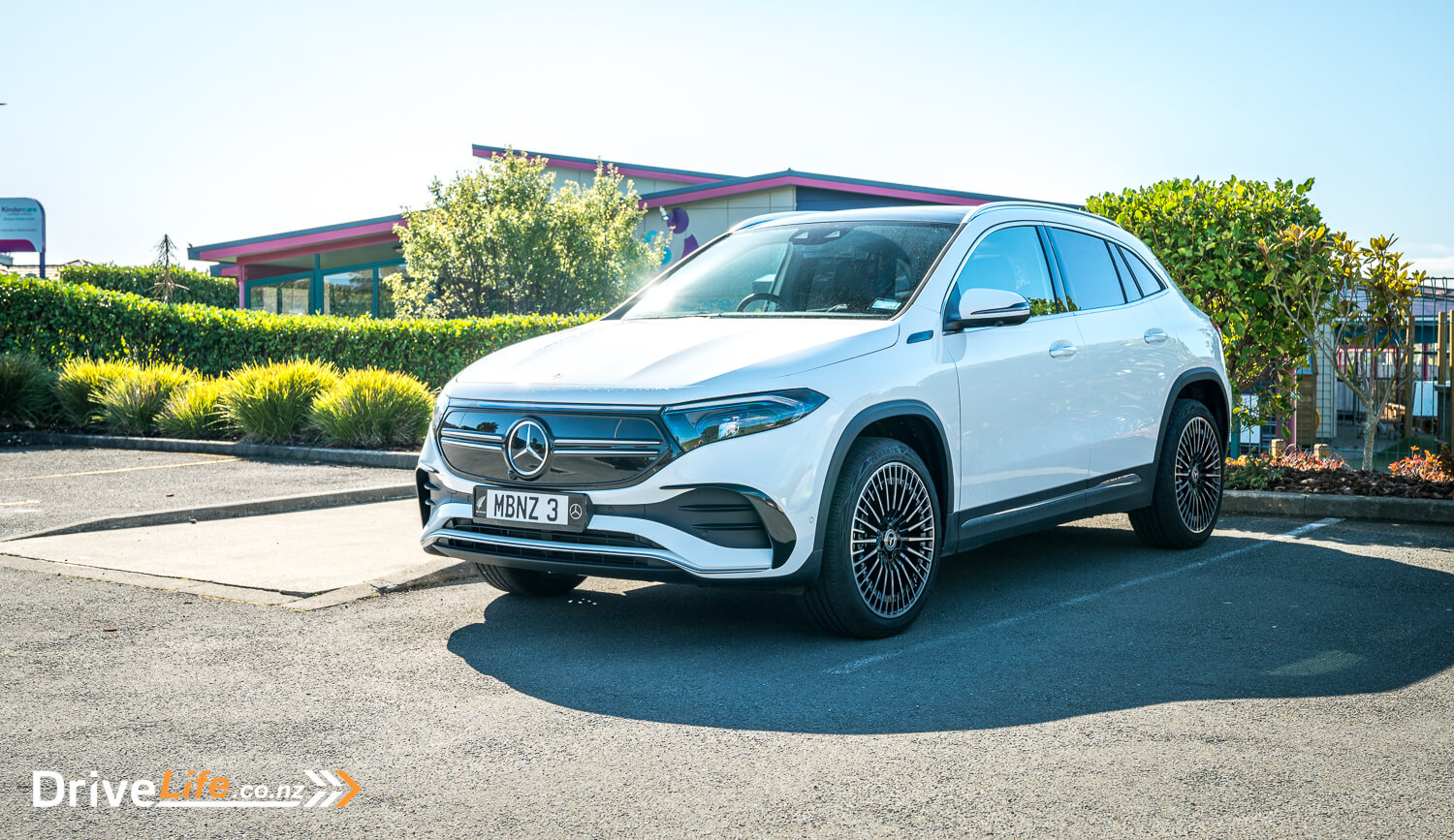
First Impressions Of The 2021 Mercedes-Benz EQA 250
I had always thought the EQA looked like a squished-down version of the EQC, and I was right on the money. The two models are extremely similar, right down to those (optional) 20” turbine-like wheels (which I don’t really like – too 80s for me).
That said, it’s not a bad looking car at all, even finished in the unexciting Polar White of our test car. I guess my second first impression was its size – I really didn’t expect it to be that big, or tall. In the photos, it certainly looks more like a small SUV (like the Kona EV), but in the flesh, it’s a whole lot bigger. I know the EQA is based on the Mercedes-Benz GLA, but it does feel like it’s on another level in size.
EV identification is fairly subtle, with an EQA badge on the front fenders, and one on the tailgate. So you might never know, although I had people asking if it was an EV, just by them looking at it. So yes, it does have that EV look about it. I expect it’s the lack of a grille that gives it away, although it’s nice that Mercedes-Benz has fitted a black panel in its place to keep it looking contemporary.
The rear end is where it looks amazing, with that full-width LED taillight bar, and nice proportions.
Our test car was fitted with the AMG Sport Line package, so for the exterior this meant:
- AMG-specific front apron with trim parts in chrome plus functional air curtains
- AMG-specific black panel radiator grille in a twin-blade design and surround in high-gloss black
- AMG rear apron in a diffuser look with trim part in chrome
- 20″ AMG multi-spoke alloy wheels, painted in high-gloss black with a high-sheen finish
There’s little doubt this alters the look of the car significantly, but the other more standard EQAs we’ve seen look just as good. Well, except perhaps for those wheels. I think the standard 19” rims look far better – more modern and tasteful, and would be the ones I would go for.
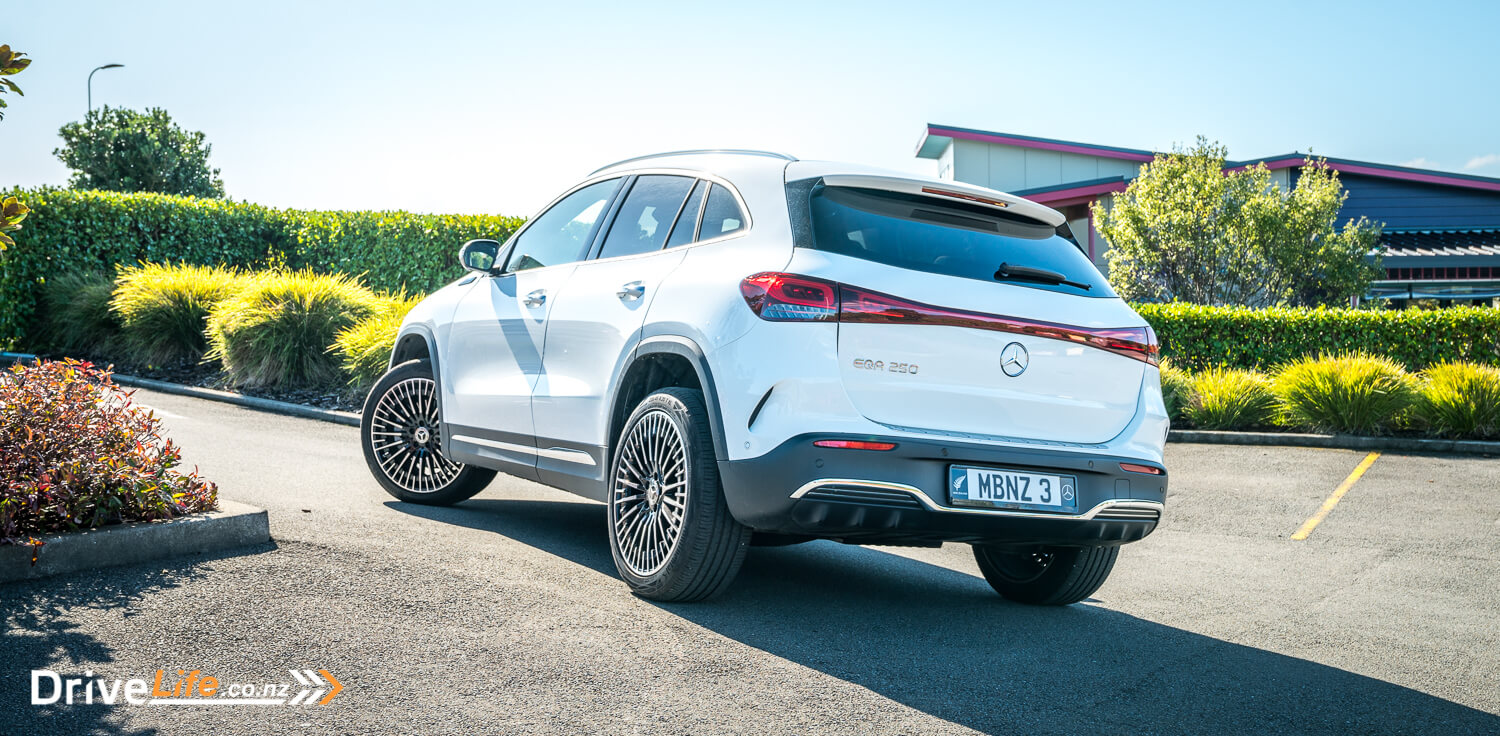
What’s The Interior Like In The 2021 Mercedes-Benz EQA 250?
To start with, we compared the EQA with a Hyundai Kona EV and Kia Niro EV. That might seem a bit ridiculous, but it’s not – they are very close in price. However, our test EQA was fitted with around $10K in optional extras. For the sake of keeping this review in comparing apples with apples, we are going to ignore those extras and any impact or benefit they might have on the look, interior, or driving of the EQA.
That means for the interior, we will ignore the panoramic sunroof, the upgraded sound system, and some extra contrasting stitching. In fact, the $2,950 AMG Line Sport Line packages comes with all this:
- Topstitching on the dashboard and beltline
- Backlit trim – only in conjunction with Spiral-look interior trim elements
- Air vents in silver chrome with outer ring in silver chrome and air guide ring in high-gloss black
- ARTICO (or, Artificial Cow) man-made leather / DINAMICA microfibre in black with red double topstitching
- Sports seats with adjustable head restraints
- Multifunction sports steering wheel in nappa leather, with flat-bottom section
- AMG pedals in brushed stainless steel with rubber studs
- AMG floor mats
While I might have thought that Mercedes-Benz would skimp on the interior of the EQA to save money, they definitely haven’t. It’s all typical Mercedes in there, and that means excellent build quality, high-end fabrics, and materials that scream out quality.
There’s Alcantara on all the doors, and as always, it feels excellent to the touch as well as lifting the quality of the interior. There’s contrasting red stitching all over the cabin, but of course, some of this is part of the optional package. It still looks great.
Up front there’s a Qi wireless phone charging pad, and a sliding cover that goes over your phone to reduce the temptation of looking at it, as well as the console looking quite cool and minimalist when the cover is used. A small point, the cover also goes right over the cup holders.
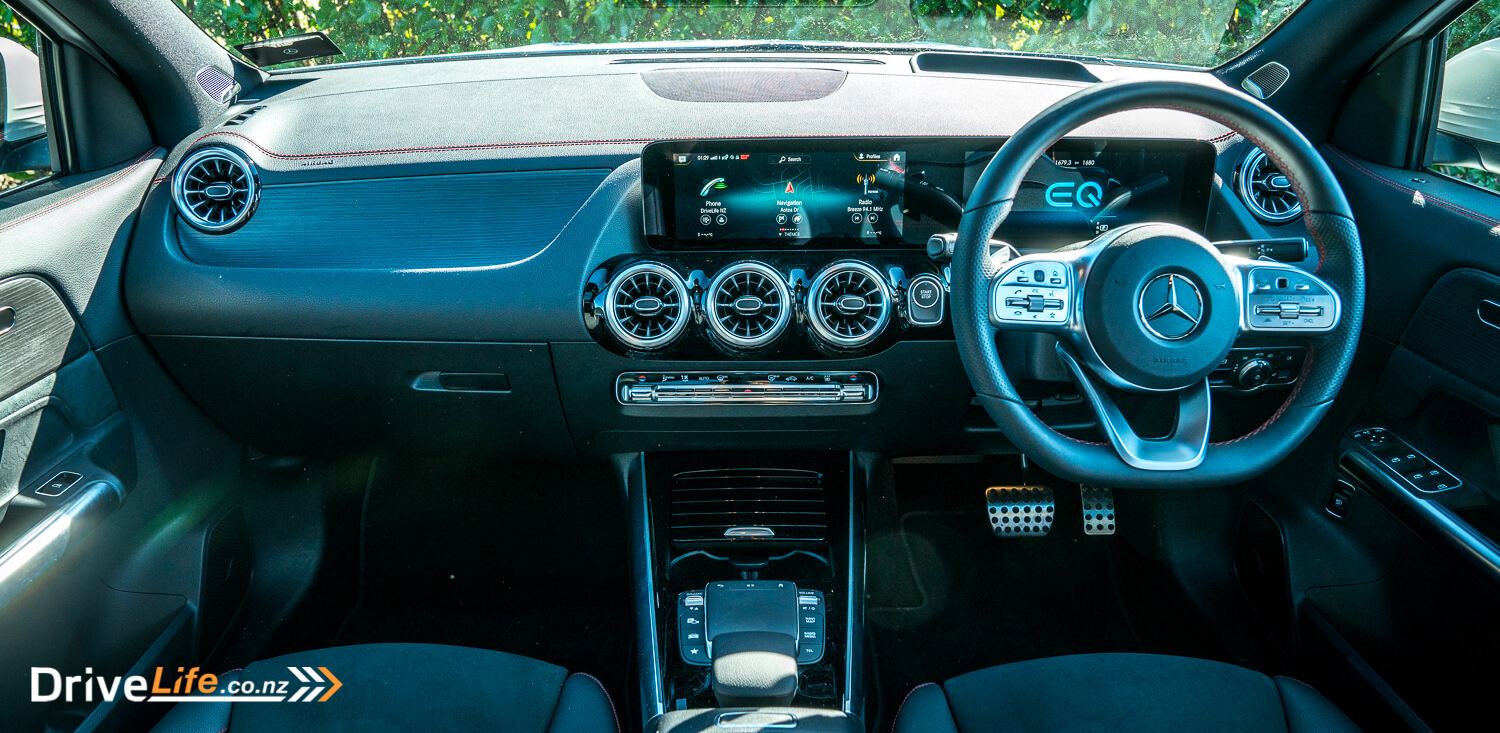
Next to the wireless charging pad there’s a single USB port, as well as two USB-C ports inside the centre console cubby. The cubby itself is quite narrow, but it’s nicely deep.
Since our test car had upgraded fabrics and other items mentioned above, it’s hard to say what the standard car is really like. However, if past experience is anything to go by, it will still be an extremely pleasant place to spend on a long drive upcountry.
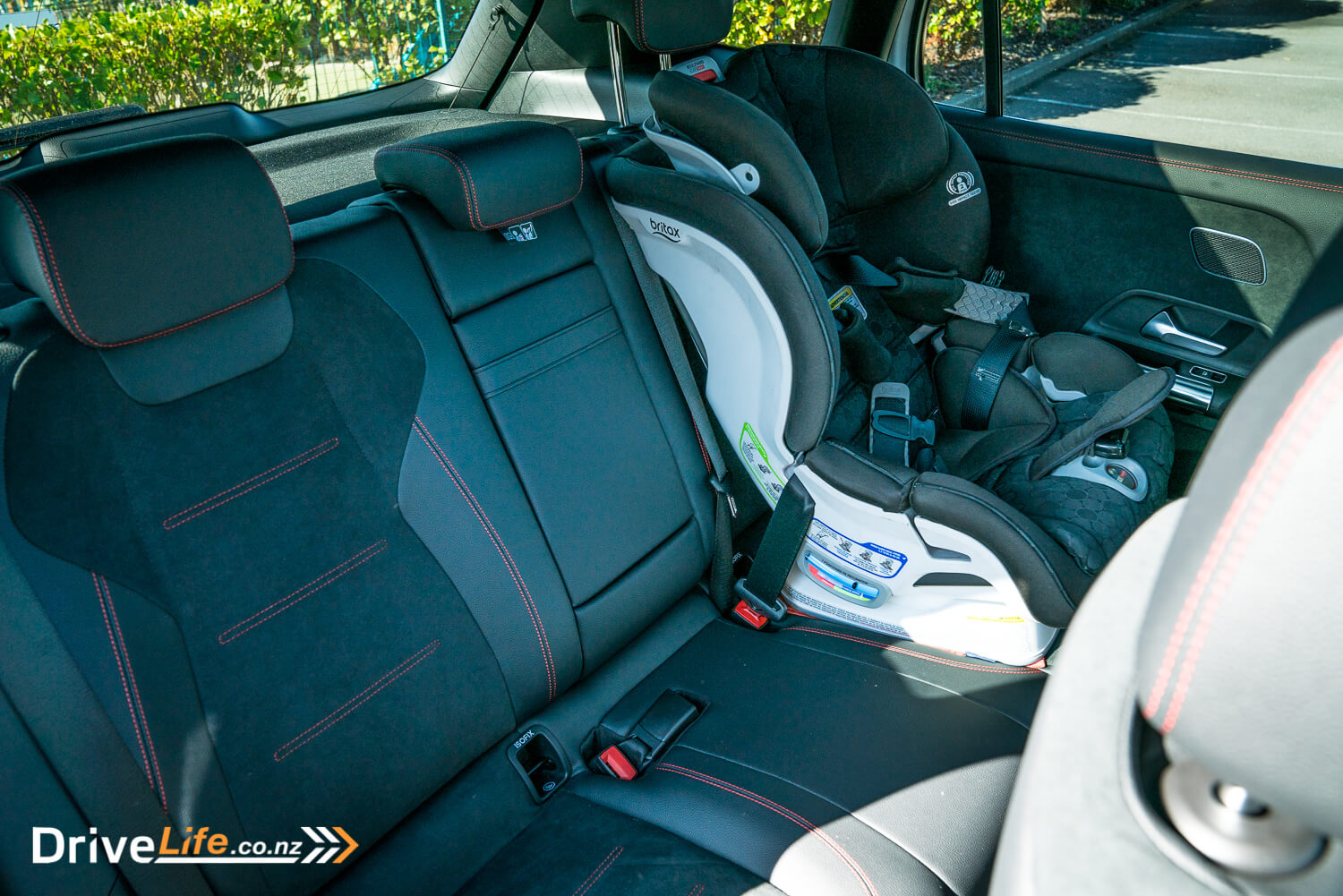
In saying that, everything in there is black and without that (optional) panoramic sunroof, I expect it’d be a pretty dark cabin. If I were buying an EQA, I would definitely spec up to get the sunroof.
Rear legroom is around average for this class but not cramped at all, while rear headroom is very good.
The boot at 340 litres with the seats up is very usable in shape.
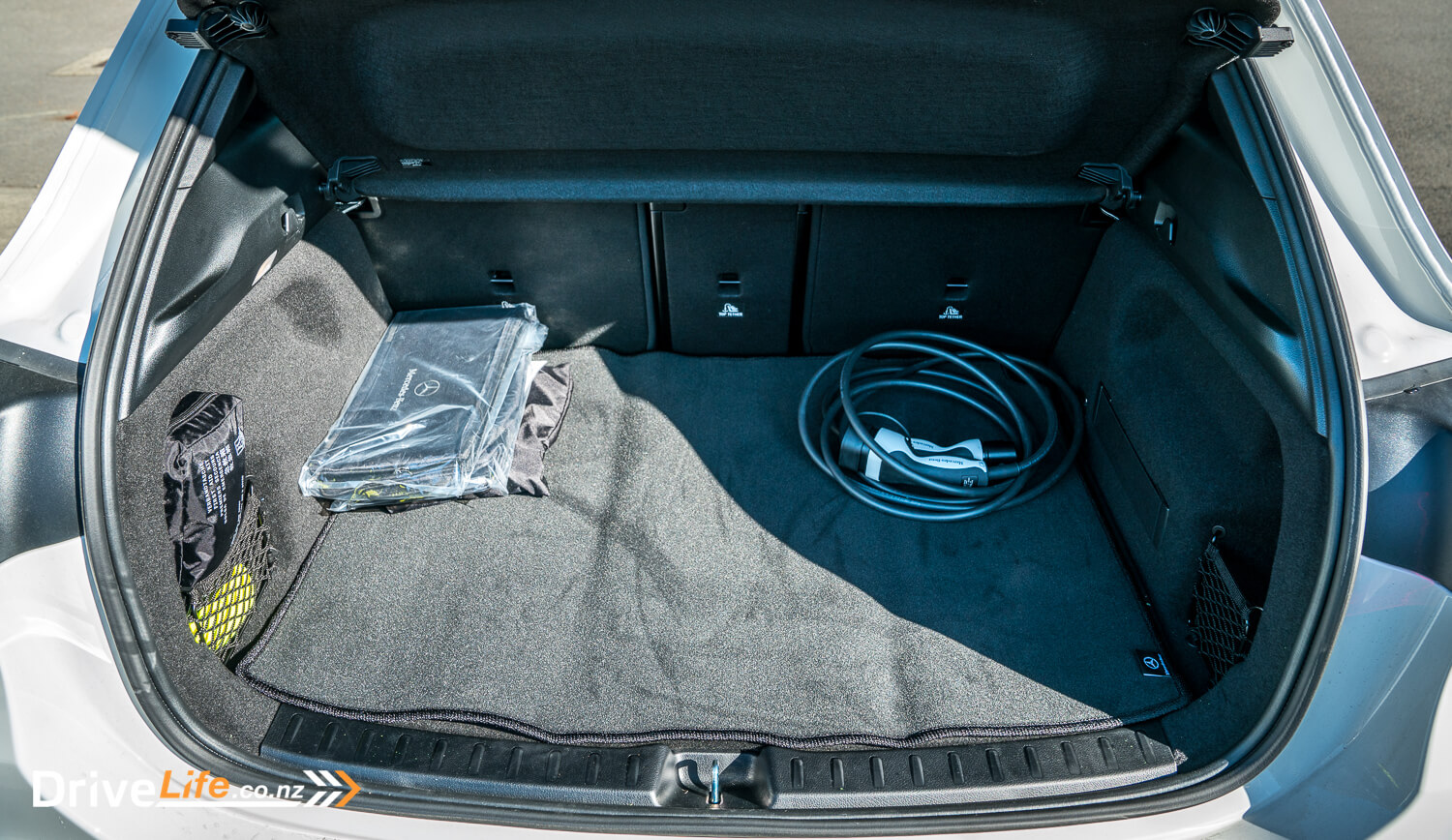
What’s The 2021 Mercedes-Benz EQA 250 Like To Drive?
While it would’ve been perfect to get the base model EQA, we’re going to ignore the optional extras as part of this review. That’s not easy, as there’s quite a bit of extra kit thrown into our test car.
This means that the Vision Package has been added, and that includes a Burmester 12-speaker surround sound system rated at 590 watts, a panoramic electric tilt/slide sunroof with an electric blind, and the Parking Package that includes a 360-degree camera.
It doesn’t stop there as we also got the MBUX Innovation Package that includes a heads-up display, augmented reality for SatNav, and the MBUX Interior Assistant.
So it’s down to nuts and bolts for this review of the 2021 Mercedes-Benz EQA; what’s it like to live with when you take away almost $10K in extras?
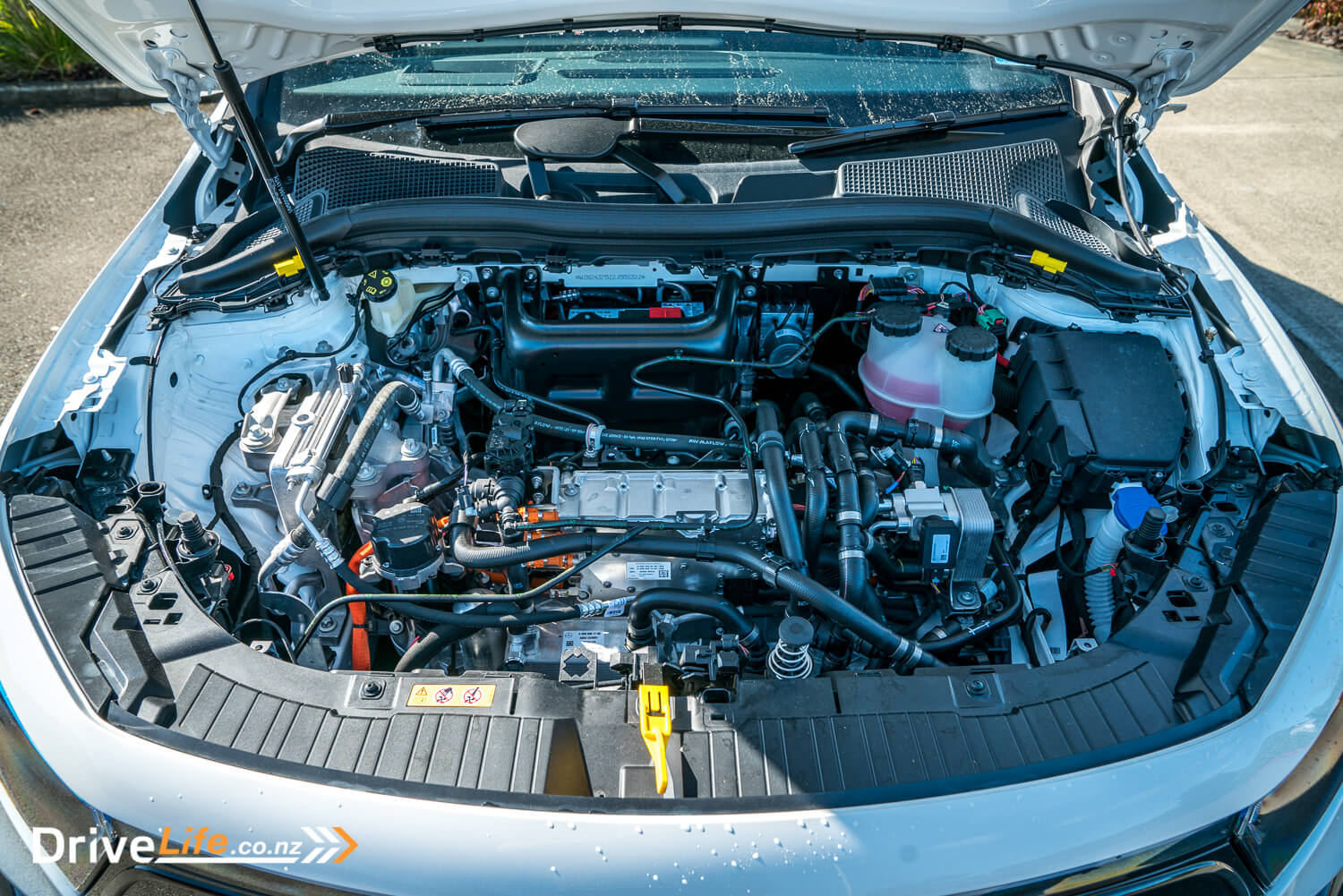
Actually, it’s still pretty nice. As mentioned, the interior finish quality is standard Mercedes-Benz, so that means excellent. Using the EQA as a daily driver was a painless and enjoyable experience. We’ve often said that EV range isn’t everything and you can easily adjust your driving or your day to charge if needed, but the EQA with its 400Km range did help matters. I simply didn’t worry about it.
When I picked up the EQA, it had 397Km range showing, a good start to this review. Heading away from the dealership, the first thing struck me was its regenerative braking. It defaults to a standard mode (‘D’) every time you get into the car, and the regen for that mode is about the same as a petrol car with an automatic transmission. But pull the left paddle once (D-), and instantly that regen increases massively. Pull the paddle again (D- -), and the EQA may well come to a stop on a hill. It’s extremely severe but once I got used to it, I drove the car using the paddles to maintain my deceleration. Not quite one-pedal driving, but close to it. If you get the brake regen back to the standard setting and then pull on the right paddle, the EQA will go into a coast mode (showing D+ on the display), which is handy if you don’t need to slow down, but want to maintain momentum.
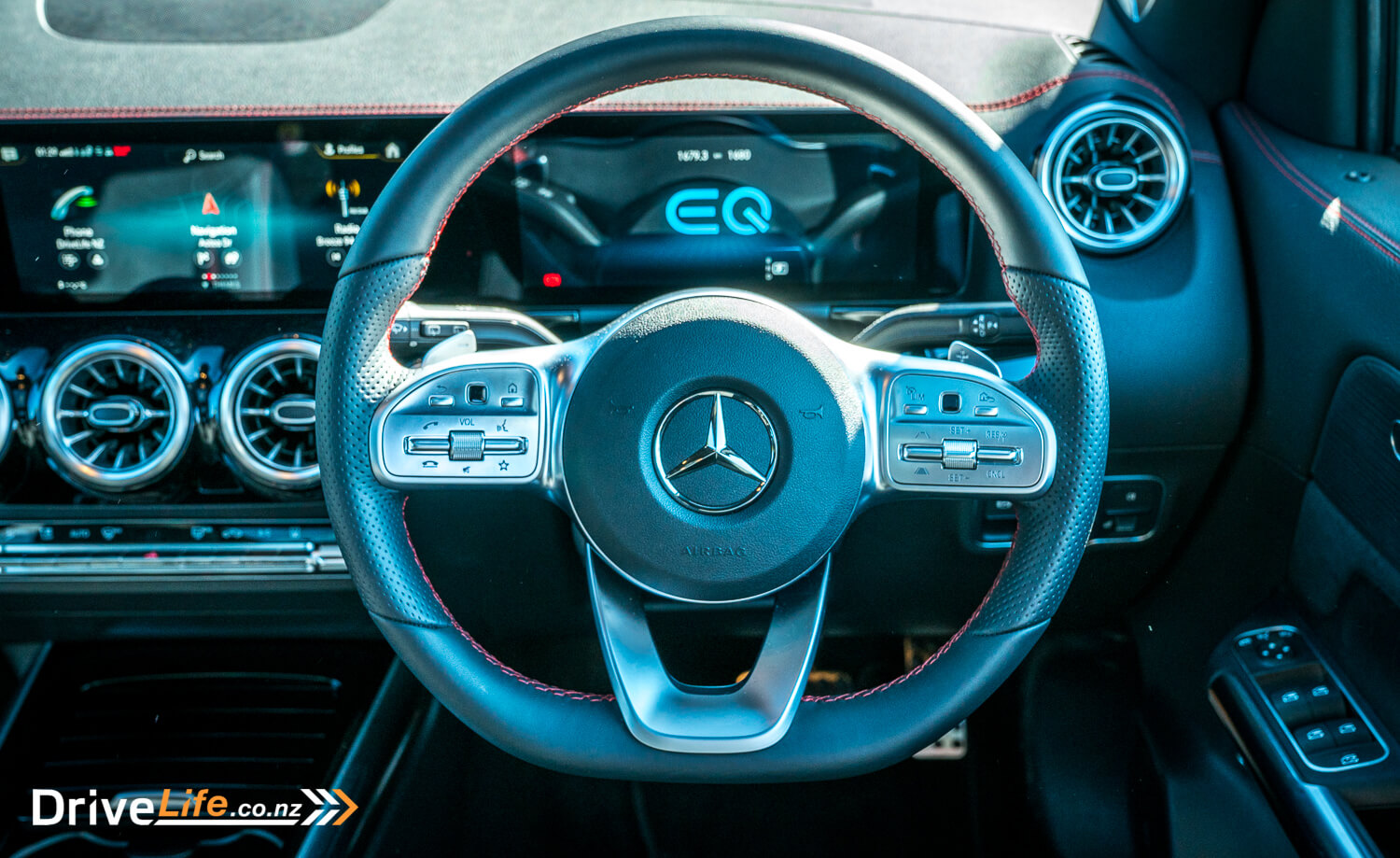
Drive modes are standard Mercedes-Benz; Eco, Comfort, and Sport. Eco mode still has plenty of go to keep up with traffic, and is easily usable, although the accelerator pedal does get a lot harder to push down. The car will always default to Comfort mode when you get in.
In the past when reviewing hybrids or EVs, I’ve often taken the angle of driving it as economically as possible, switching off AC etc to get the max distance from the car. Not this time. I decided to just drive the car as I would drive any other car, aircon on, Sport mode when I wanted it, and EV economy be damned. So very much real-world driving. You’ll see my result at the end of this review.
Speaking of Sport mode, well it makes the EQA boogie. While it’s no iPace in performance, the EQA will get to 100km/h in 8.9 seconds, enough for most drivers. In Sport mode, it feels a lot quicker than that, and passing acceleration is excellent. Bear in mind that the EQA is front-wheel drive only, so this means you can get those front wheels spinning relatively easily.
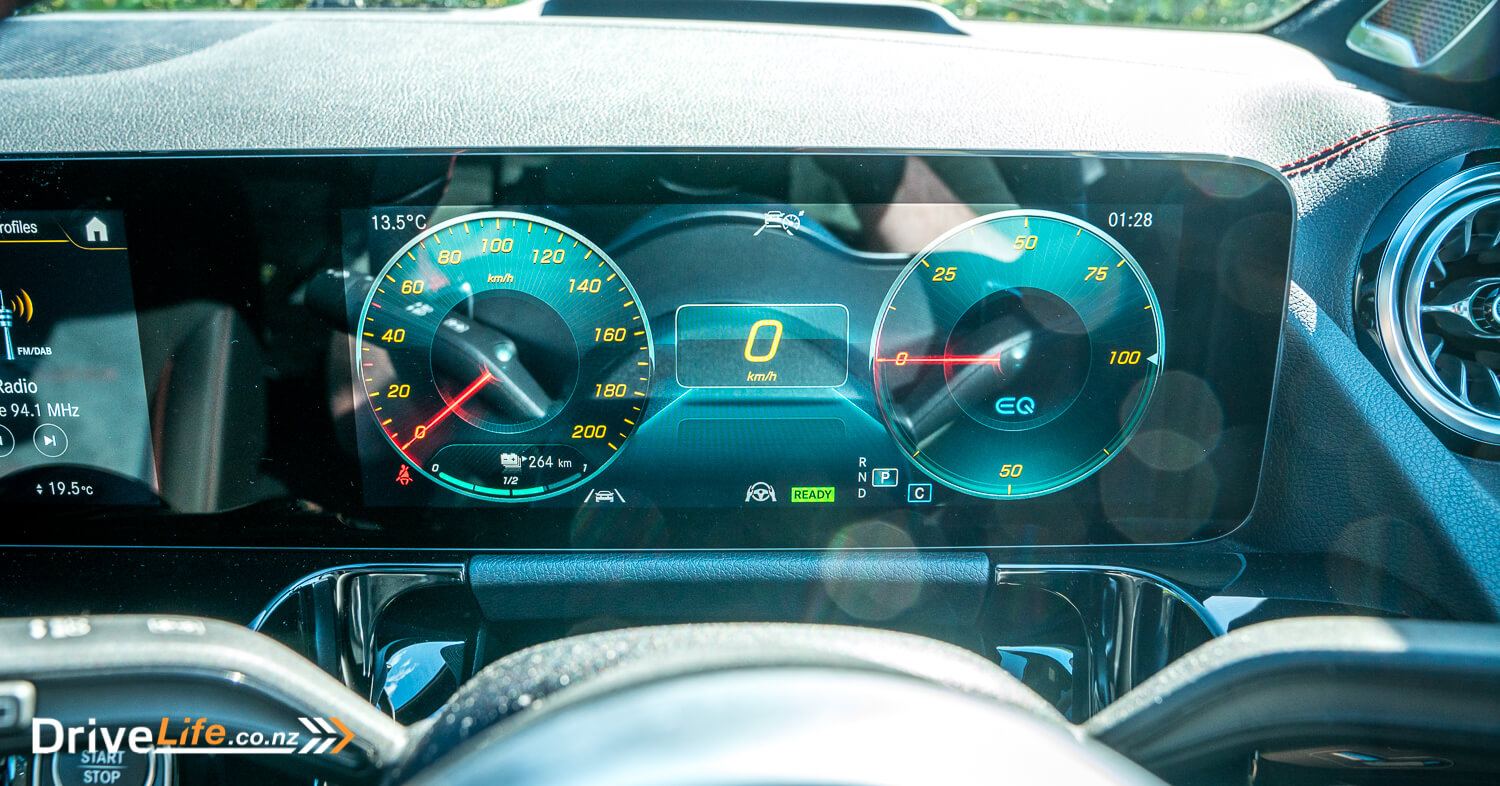
I decided to do a day trip to Masterton, around 109Km each way. The car showed 181Km of range, so I’d have to charge up while in Masterton, no big deal. I called up the SatNav saying “Hey Mercedes, navigate to Masterton”, the car set my course and away we went. On the motorway, I used the car’s excellent adaptive cruise control. While the EQA doesn’t do stop/go under adaptive cruise (it will bring the car to a stop, but not start off again) it does use the adaptive route-based system. Essentially this is a GPS-tracked system where the car will slow down for a corner. Yes, it still slows the car down more than I’d like, but for ‘average’ drivers, it’s probably about right. It does save that freak-out moment when you are using cruise control and then end up flying around a corner faster than you wanted to. The EQA’s adaptive cruise control is one-touch as well, so it’s just hit the ‘Set’ button and it’s on. As well as that, you can double-tap the ‘Resume’ button and the car will set the cruise control speed to the current speed limit. All handy stuff.
Motorway travel is quiet, as it should be in an EV. But to be fair, wind noise and road noise are very well subdued. Tyre noise does make an appearance depending on the road surface, but we often find that eco tyres fitted to EVs can be a little noisy. The EQA is fitted with Continental Eco tyres.
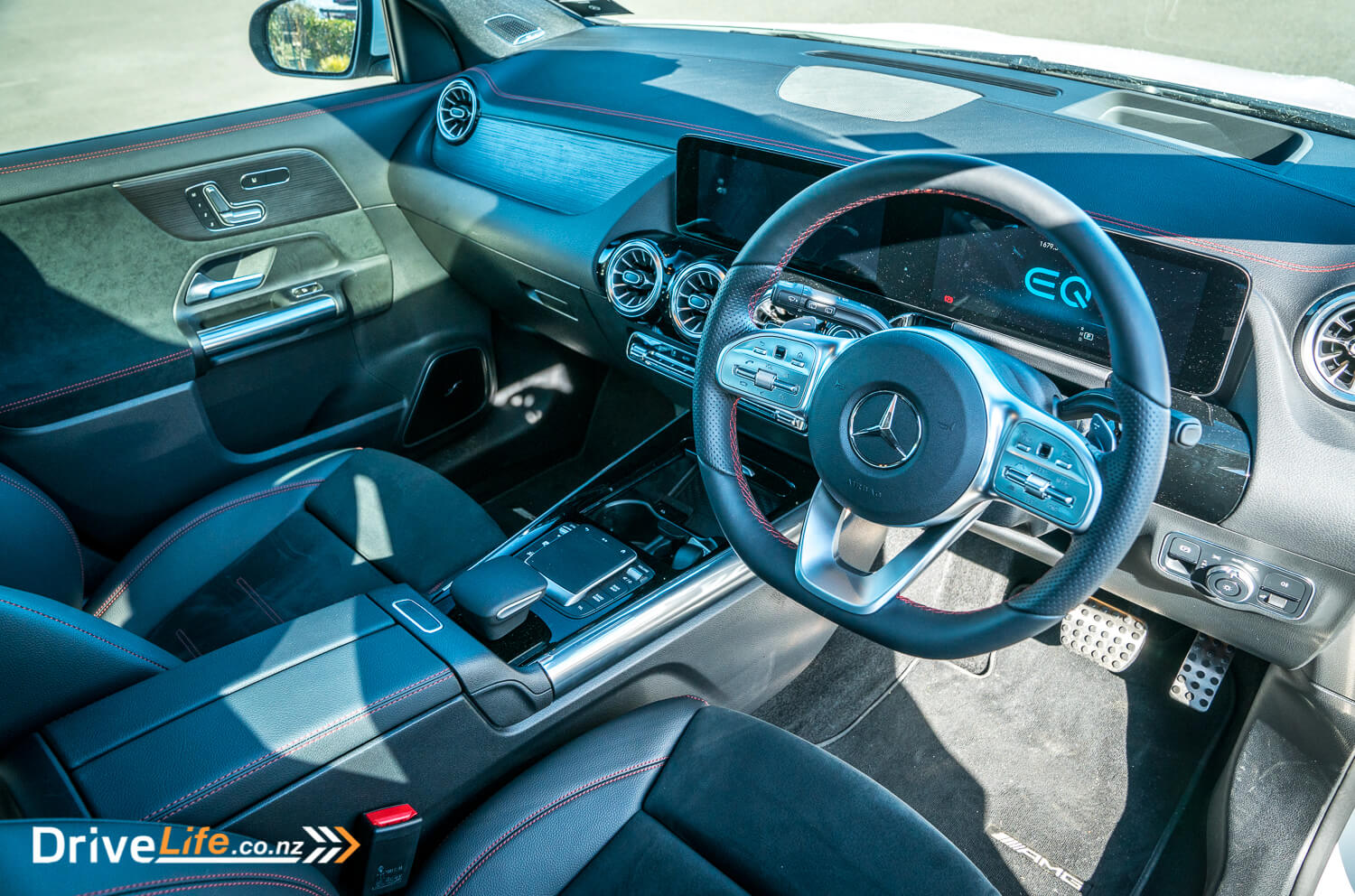
Heading over the Remutaka Hill on a weekday with little traffic, and the EQA fair flew up the Wellington side of the hill. Handling was surprising; I’ve found EVs to generally be good at handling, with the weight of the batteries down low helping to keep the car planted and reducing body roll. But the EQA feels tall, so it was a nice experience that it can handle reasonably well.
Part of this for me was down to that aggressive regen; I left the car in D- – brake regen mode, so on the maximum. It meant I could come up to a corner and just gas off, and let the regen bring my speed down, without any weight transfer to the front as you would normally get using the brakes. If you push it hard enough there will be tyre squeal and understeer, but it’s all fairly drama-free. The car will spin the inside front wheel on a corner under hard acceleration but that’s to be expected.
I guess one negative for me on that windy road were the seats; while the bolsters look nice and chunky, I found myself being tossed around a bit. While Mercedes-Benz seats are generally very good, if not excellent, for my entire week with the EQA I could not get my seating/steering wheel position just right. I also found that even with lumbar adjust turned all the way back, there was still something in the lower part of the seat pressing against my lower back. The others who had the car after me didn’t report this, so that’s just my view.
Under the ‘Comfort’ setting in the MBUX system, you can turn on Seat Kinetics. While this isn’t a massaging system, it means that the car will use the electric motors in the seat to move it around slowly and gently, so on a long trip, you are getting some sort of different movement going on. Both front seats do this.
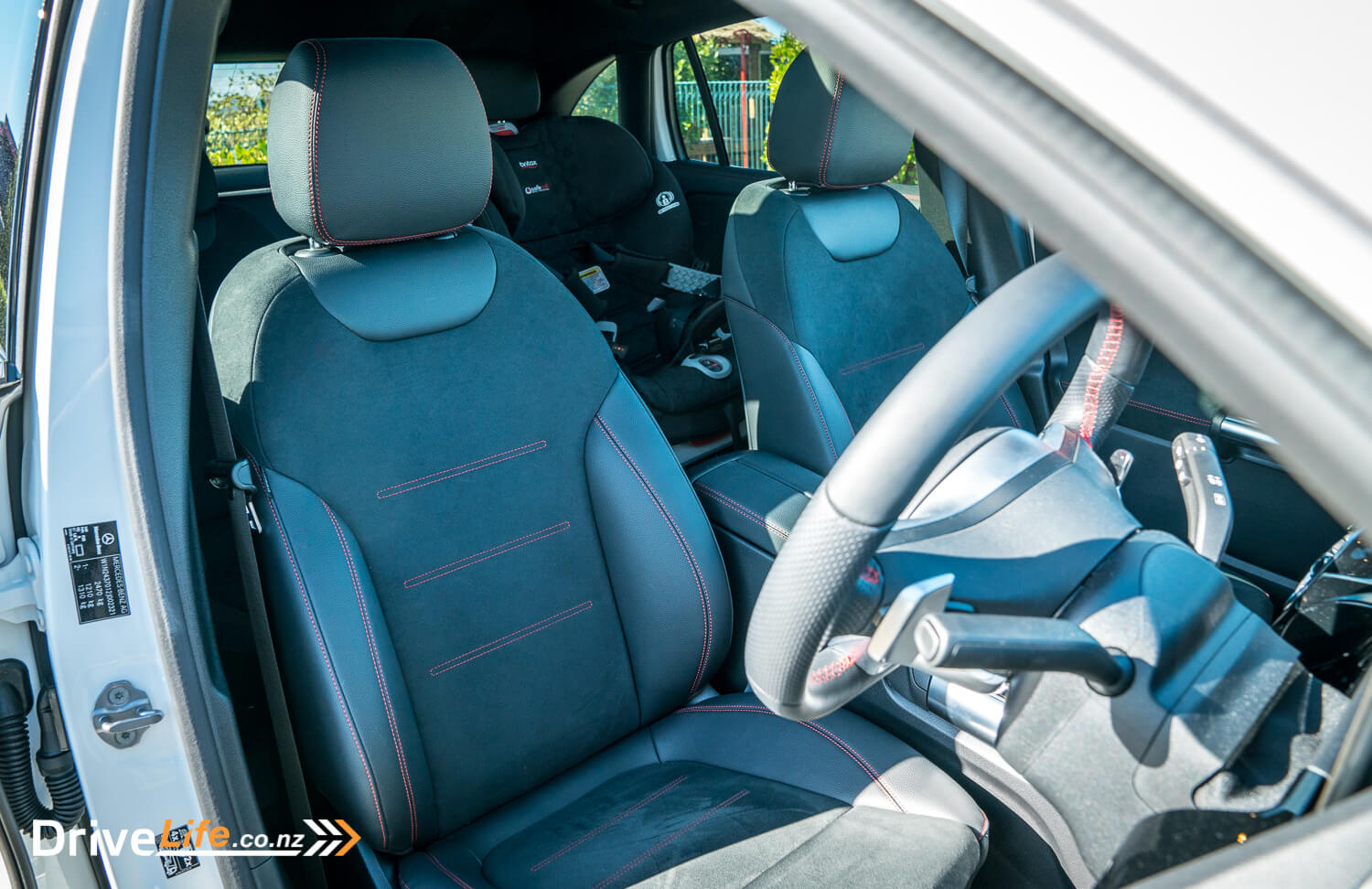
Arriving in Masteron, I had 37Km of range left. This may freak some people out, but after being in so many EVs it was a ‘meh’ moment. It is no problem to charge the car up, and I did that while having lunch.
So with that 37Km range remaining, that meant that while the car said I had 181Km of range total, I should have had 72Km of range left in Masterton. Still, that’s relatively close. Keep in mind that it’s difficult to equal a petrol car’s stated fuel consumption as well, so this is no different in that respect.
Heading home at night, the ambient lighting looks very cool. When I picked the car up it was set to brightest, but it’s easy enough to turn this down to whatever level you want. You can pick from 64 ambient lighting colours, and these are embedded in LED strips into the doors, dash, and centre console.
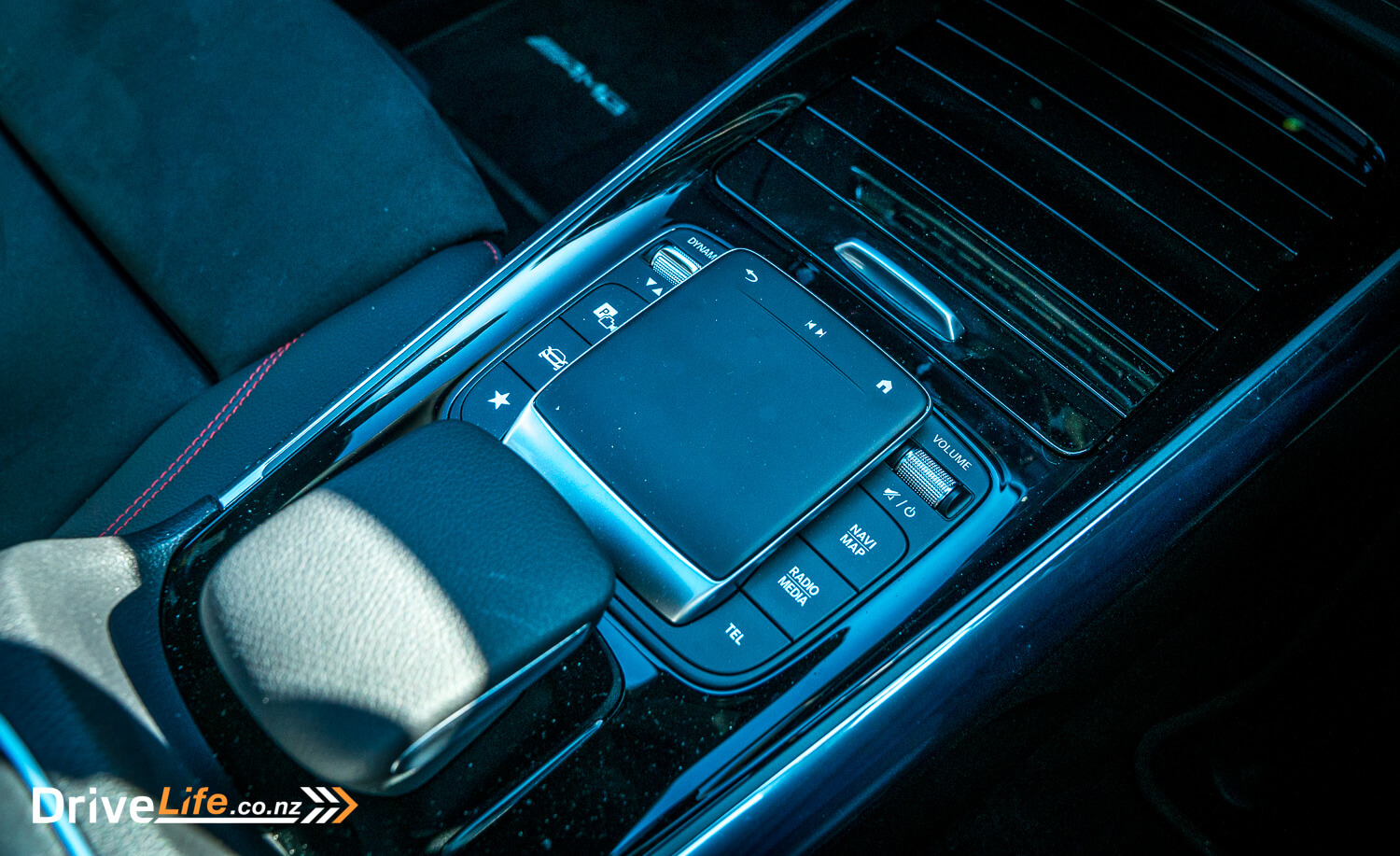
Even opening the door at night is a little special, with that huge Mercedes-Benz star projected onto the footpath. We’ve seen lots of cars with this feature, but that star is enormous. Talking about the doors, there are the perfect grab handles on them. It’s a solid round piece of alloy, that you can wrap your whole hand around. In Wellington’s sometimes windy weather, it was great to know you had a firm grasp of the door before the wind took it away from you.
So for EV economy, how did I go? I covered 500Km in the EQA 250, and Mercedes-Benz suggests it should use 16.2kWh of power for every 100Km driven. Using my real-world approach, I got 21.3kWh.
Comparing that to other real-world numbers in our own reviews, the Mazda MX-30 did 17.6kWh, the Tesla Model 3 did 22kWh, and the Mercedes-Benz EQC 23.3kWh. That makes the EQA 250 fairly high in energy economy, for the size of the car.
Alistair’s View
There are two words I hear frequently within the automotive industry. Both words fail to excite me.
The first is “crossover”. The crossover is like a cheeseburger from McDonalds. They’re a prolific, occasionally nice, and designed to sell for the mass market. Serves a purpose, but seldom in a memorable way. The second is “EV”, or Electric vehicle. EV’s can be very good, but many have a homogenous driving experience. EV’s are also still compromised on range, and they are usually eye-wateringly expensive.
So, the Mercedes EQA was fighting against some natural prejudices before I even drove it; Surely an EV crossover was going to be the most delightfully average vehicle I’ve tested in a while? Not so.
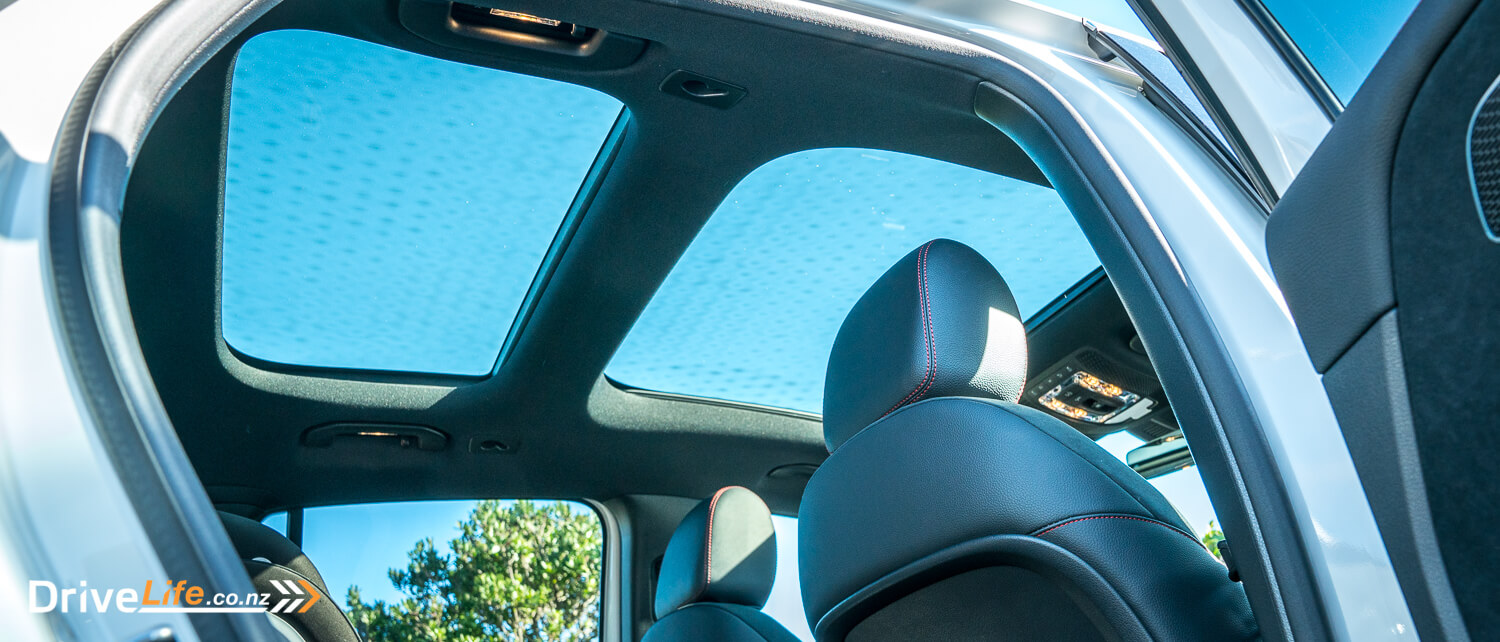
Instead, it was nearly the complete opposite. First-off, EV’s are quiet and refined, which is the perfect basis for a luxury car. Then throw in everything that makes it a Merc – a supremely comfortable cabin, excellent materials, good ride quality, and some of the best in-cabin and driver’s tech on the market.
Even better was the price point. I was expecting the EQA pricing to be absolutely stratospheric, but instead, it’s priced around that of a Mercedes GLA 250, the brand’s own equivalent, internal combustion vehicle.
If I were being picky, I’d say that the EQA was not the most exciting driving experience. It’s also quite energy-hungry, and the infotainment trackpad can be a bit abstruse.
But make no mistake, the Mercedes EQA is an excellent vehicle. Much better than a McDonald’s cheeseburger.
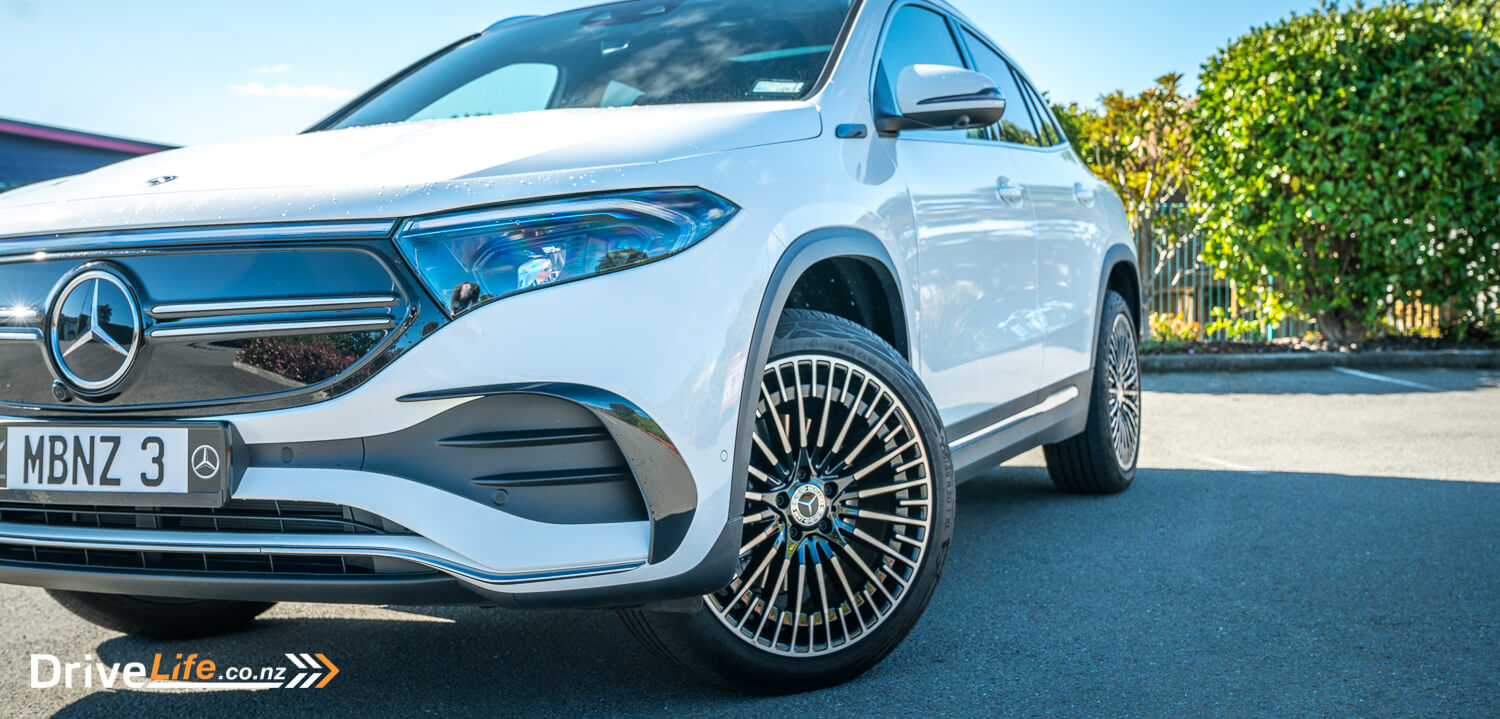
John’s View
I spent a week in the driver’s seat of the EQA 250 not long after my time in the Mazda MX-30. I have to say that I didn’t have much to complain about. Great space inside the cabin, both front and back, big boot, nice toys, and an easy EV interface. It felt just like a normal car, but with a different power train which was nice, no gimmicks, just an everyday practical vehicle.
I really liked the more intense brake regeneration that you were able to employ over most other EV’s, sometimes it felt like too much, but if used in the right location, you could visibly see your range tick up. Most EVs it’s never strong enough, but the EQA allows you to make it too strong for when you need it.
As EV vehicles go, this has been my favourite so far. It’s just like an ICE SUV but it’s electric, no funny quirks, designs or weird controls. Most of the time I forgot it was an EV, which is a home run for me.
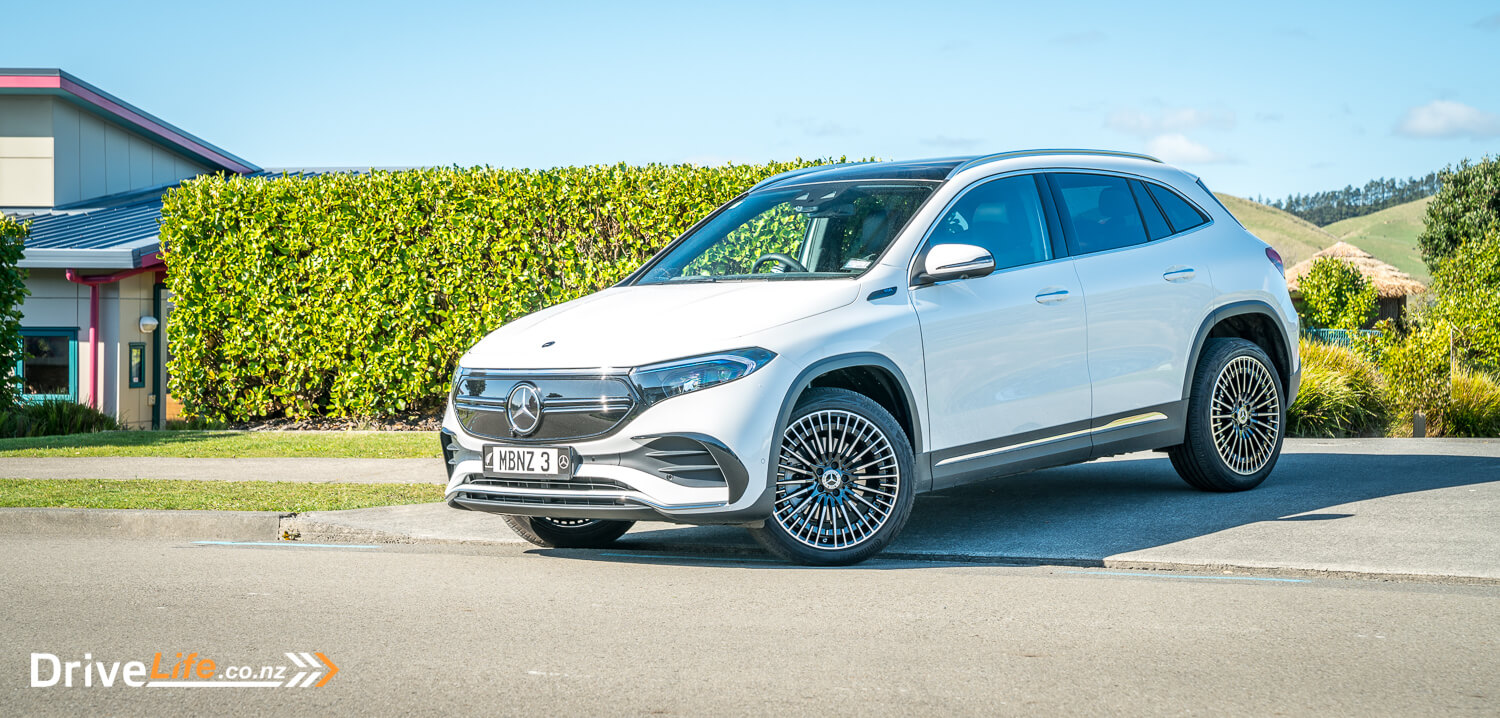
Rob’s View
After almost a week with the EQA, it’s officially my new favourite EV, taking over from the i-Pace Jag. It looks great – smart and premium without being flashy or too “EV-futuristic”. Size-wise it’s just about perfect for me. It handles well, it’s comfortable, and as Fred says, in Sport mode it feels quick. There is some torque-steer when you floor the pedal but generally, it’s very well-behaved.
My daily is a Mercedes C200 wagon and I love that car for all of the same reasons I like the EQA. Quality, comfort, ease-of-use. But the EQA adds an extra level of quiet and refinement to the driving experience. This is the EV experience I want – a practical, premium-quality car at a surprisingly good price point, and no unnecessary gimmicks or silly controls (I’m looking at you, Tesla).
The more I drive EVs, the more relaxed I get about range. Fred gave the EQA to me with 200km range, and I just hopped in and drove it like I would my own car. I plugged it in every other night but didn’t really need to do it that often. For my use, every three or four days would have been plenty.
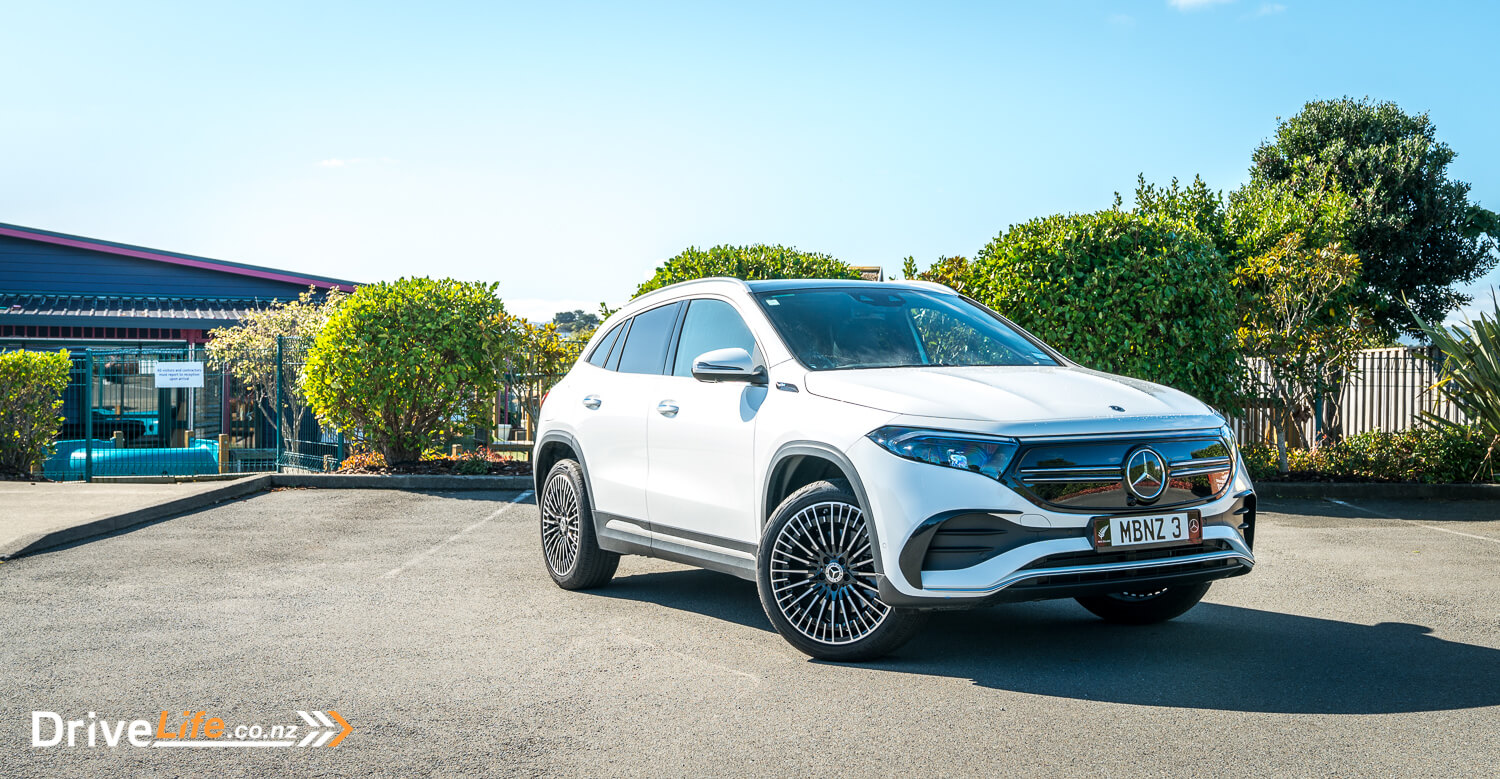
2021 Mercedes-Benz EQA 250 – Specifications
| Vehicle Type | 5-door, front-wheel-drive, small/medium-sized electric SUV |
| Starting Price | $85,500 |
| Price as Tested | $94,150 |
| Engine | Single electric motor |
| Power, Torque kW/Nm | 140 |
| Spare Wheel | TIREFIT kit and compressor |
| Kerb Weight, Kg | 2,040 |
| Length x Width x Height, mm | 4463x1834x1620 |
| Cargo Capacity, litres | 340 |
| Battery Capacity, kWh | 66.5 |
| Energy Economy, kWh/100km | Advertised Spec – Combined – 16.2 Real-World Test – Combined – 21.3 Low Usage: 6-10 / Medium Usage 11-18 / High Usage 19+ |
| Towing Capacity Kg, unbraked/braked | NA |
| Turning circle, metres | 11.4 Small: 6-10m / Medium 10-12m / Large 12m+ |
| Warranty | 3 Year Warranty Battery Warranty 8 years/160,000Km |
| Safety information | Ancap Rating – 5 stars Rightcar.govt.nz – 5 Stars |


